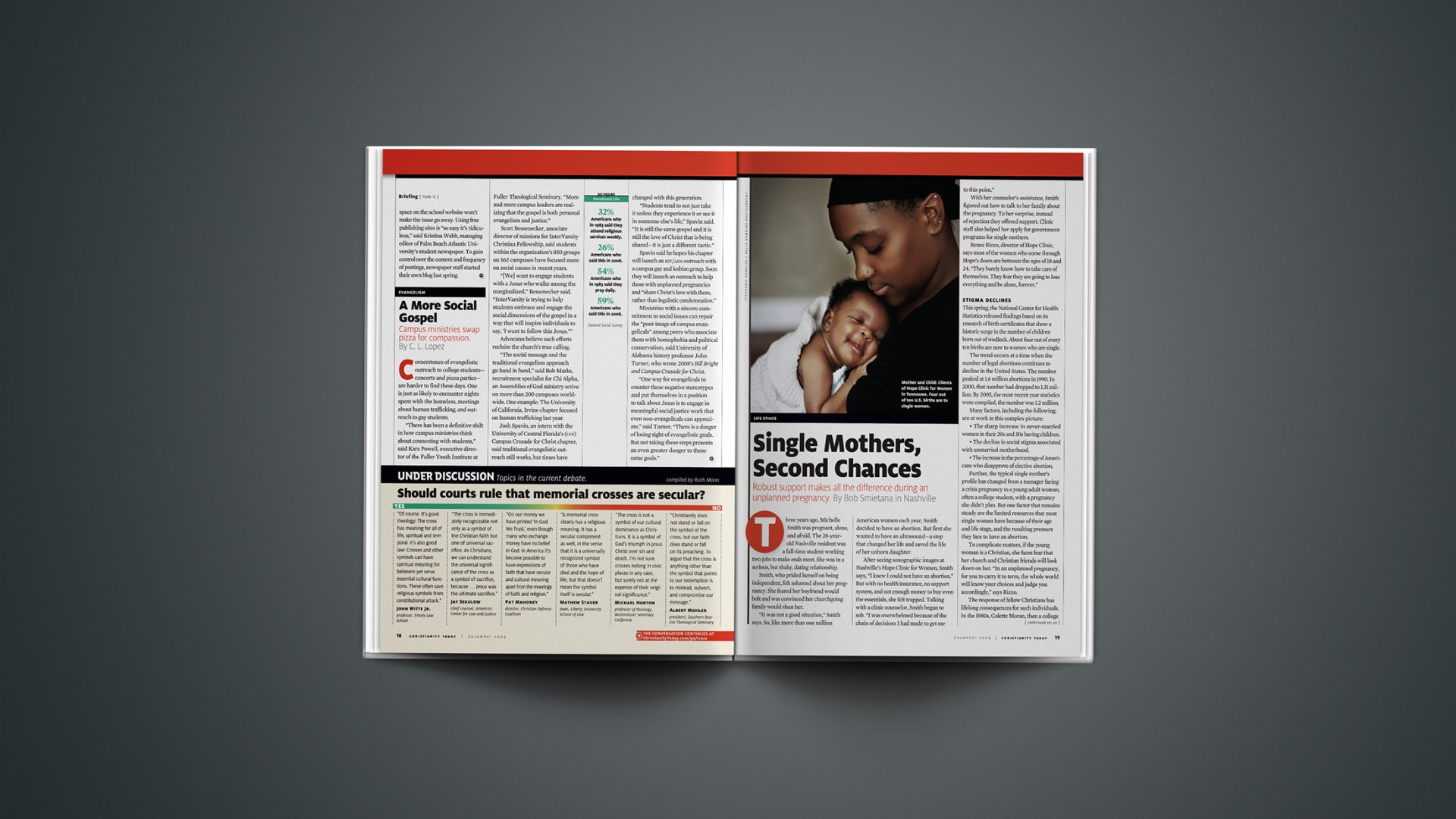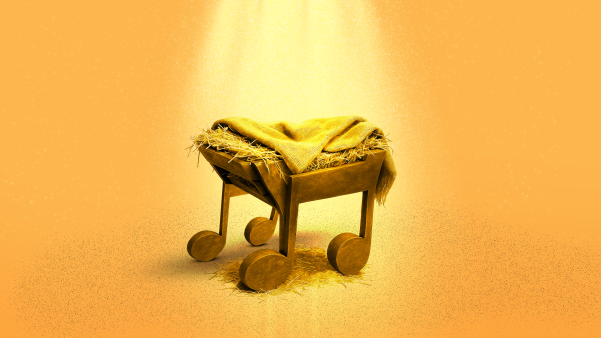Three years ago, Michelle Smith was pregnant, alone, and afraid. The 28-year-old Nashville resident was a full-time student working two jobs to make ends meet. She was in a serious, but shaky, dating relationship.
Smith, who prided herself on being independent, felt ashamed about her pregnancy. She feared her boyfriend would bolt and was convinced her churchgoing family would shun her.
“It was not a good situation,” Smith says. So, like more than one million American women each year, Smith decided to have an abortion. But first she wanted to have an ultrasound—a step that changed her life and saved the life of her unborn daughter.
After seeing sonographic images at Nashville’s Hope Clinic for Women, Smith says, “I knew I could not have an abortion.” But with no health insurance, no support system, and not enough money to buy even the essentials, she felt trapped. Talking with a clinic counselor, Smith began to sob. “I was overwhelmed because of the chain of decisions I had made to get me to this point.”
With her counselor’s assistance, Smith figured out how to talk to her family about the pregnancy. To her surprise, instead of rejection they offered support. Clinic staff also helped her apply for government programs for single mothers.
Renee Rizzo, director of Hope Clinic, says most of the women who come through Hope’s doors are between the ages of 18 and 24. “They barely know how to take care of themselves. They fear they are going to lose everything and be alone, forever.”
Stigma Declines
This spring, the National Center for Health Statistics released findings based on its research of birth certificates that show a historic surge in the number of children born out of wedlock. About four out of every ten births are now to women who are single.
The trend occurs at a time when the number of legal abortions continues to decline in the United States. The number peaked at 1.6 million abortions in 1990. In 2000, that number had dropped to 1.31 million. By 2005, the most recent year statistics were compiled, the number was 1.2 million.
Many factors, including the following, are at work in this complex picture:
- The sharp increase in never-married women in their 20s and 30s having children.
- The decline in social stigma associated with unmarried motherhood.
- The increase in the percentage of Americans who disapprove of elective abortion.
Further, the typical single mother’s profile has changed from a teenager facing a crisis pregnancy to a young adult woman, often a college student, with a pregnancy she didn’t plan. But one factor that remains steady are the limited resources that most single women have because of their age and life stage, and the resulting pressure they face to have an abortion.
To complicate matters, if the young woman is a Christian, she faces fear that her church and Christian friends will look down on her. “In an unplanned pregnancy, for you to carry it to term, the whole world will know your choices and judge you accordingly,” says Rizzo.
The response of fellow Christians has lifelong consequences for such individuals. In the 1980s, Colette Moran, then a college senior in Chicago, discovered she was pregnant. At first, she feared that her fellow students, many of them conservative evangelicals, would shun her.
“Then I thought, If they are really Christians, they can deal with this,” she says. Indeed, most students responded compassionately to Moran, who gave birth to her daughter, Julia, a few days after graduation. There were awkward moments. “Sometimes people didn’t know what to say,” Moran says. “But I can’t remember a single negative comment.”
That didn’t mean her pregnancy was easy. Moran was covered under her family’s health plan and had a place to live. “Even with those advantages, it was almost overwhelming,” she says. Moran and Julia’s father married but divorced soon after. Moran is now remarried and has seven children.
Many young women find that an un-planned pregnancy is not the end of the world. “It’s a detour, and detours can teach you wonderful things,” says Moran.
Spiritual Assets
In 2007, unmarried women gave birth to about 1.7 million children, double the number of births to unmarried women in 1980. But support services and resources for single mothers have not kept pace with the rapid increase.
A 2007 study from Feminists for Life, a Virginia-based pro-life nonprofit, revealed that college-age women in the U.S. have one of the highest rates of abortion (47 per 1,000 pregnancies among women ages 20β4). Few colleges and universities eagerly accommodate expectant or single-parent female students, and are far more likely to provide ready access to birth control and confidential referrals to abortion clinics.
In response, grassroots pro-life activists have begun offering more services to expect-ant and new mothers. At Hope Clinic, for example, counselors help mothers-to-be map out strategies for their pregnancy and the two years following birth. They identify each mother’s strengths and needs and lay out a step-by-step plan.
Whether the new mothers succeed often depends on intangibles such as personal values, work ethic, education, life experience, and perseverance—collectively what Hope Clinic calls “spiritual assets.” “The younger you are, the less you have handled crisis in your past, the less able you are to handle this crisis,” says Rizzo.
“I see young people whose parents have bailed them out of all their problems and mistakes. [Then] this big one comes along, and they have no coping mechanisms.”
After Hope Clinic takes an inventory of spiritual assets, volunteers lead women through basic training to strengthen their assets. Volunteers spend up to 100 hours helping a woman work through her plan. Smith says that before she was pregnant, she lacked self-confidence. The process of becoming a mother transformed her life. “I’ve done a lot of growing up,” she says.
Women facing an unplanned pregnancy also need the gear that all new parents need: clothes, cribs, child seats, and playpens. And if they work, they also need daycare.
In a 2004 survey of young adult women who had abortions, the Guttmacher Institute found that 81 percent of respondents said they lacked financial resources to afford a baby and pay for childcare. These and similar findings have galvanized the pro-life community.
Earlier this year, Lincoln Davis (D-Tenn.) re-introduced to the House of Representatives the Pregnant Women Support Act, a piece of legislation that would increase funding for food nutrition programs, health insurance, and a host of other programs intended to reduce abortions by increasing services to new mothers. The bill, which has 42 co-sponsors, was referred in late May 2009 to the House subcommittee on family health.
In addition, Democrats for Life of America has united conservative Democrats to advocate for new programs. Called the 95-10 Initiative, the strategy aims to reduce the number of abortions by 95 percent over the next 10 years by promoting abstinence, personal responsibility, adoption, and support for women facing unplanned pregnancies. The initiative also includes parental notification laws, a ban on transporting minors across state lines for abortions, and funding for ultrasound equipment.
Rep. Davis says that legally opposing abortion is no longer enough. “People get angry and they scream and shout. [But] nothing gets done for the people we all say we care about,” Davis says. “If we can pass this bill and get it implemented across the country, I believe we can dramatically reduce the number of abortions.”
More conservatives are supporting the two-track approach of legally opposing abortion and practically supporting mothers. Richard Land, president of the Southern Baptist Convention’s Ethics and Religious Liberty Commission, says that doing both, even if the latter involves government funding, is essential. “You have to do both to be pro-life,” he says.
Smith believes her own story corroborates the two-track approach. Without government-supported health care, Smith says, she could not have afforded the hospital stay. Not long after going to Hope Clinic, complications arose with her pregnancy. She ended up spending weeks in the hospital before giving birth to a healthy baby.
“A regular pregnancy is not cheap,” she says. “Having a high-risk pregnancy, I had to be on bed rest in the hospital.” Smith looks back on her pregnancy and is grateful for Hope Clinic and the government programs that helped her choose life.
She’s also the mother of a thriving 3-year-old. “She never ceases to amaze me,” Smith says. “We’re at a really great, safe, happy place.”
Bob Smietana, a
Christianity Today
contributing editor, covers religion forThe Tennessean
in Nashville.Copyright © 2009 Christianity Today. Click for reprint information.
Related Elsewhere:
Previous articles on abortion and helping pregnant women include:
Volunteer at a Center | The pro-life movement’s next move is to foster an explosion of people who do support women facing unplanned pregnancies. (October 14, 2009)
Reducing Abortion for Real | The current proposals to lower the abortion rate will only make things worse. (March 16, 2009)
Saved by sonogram | Ultrasounds help crisis pregnancy centers reduce abortion. (March 1, 2003)









